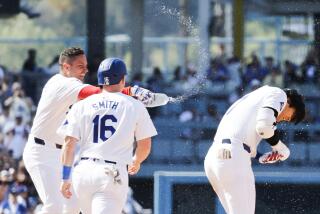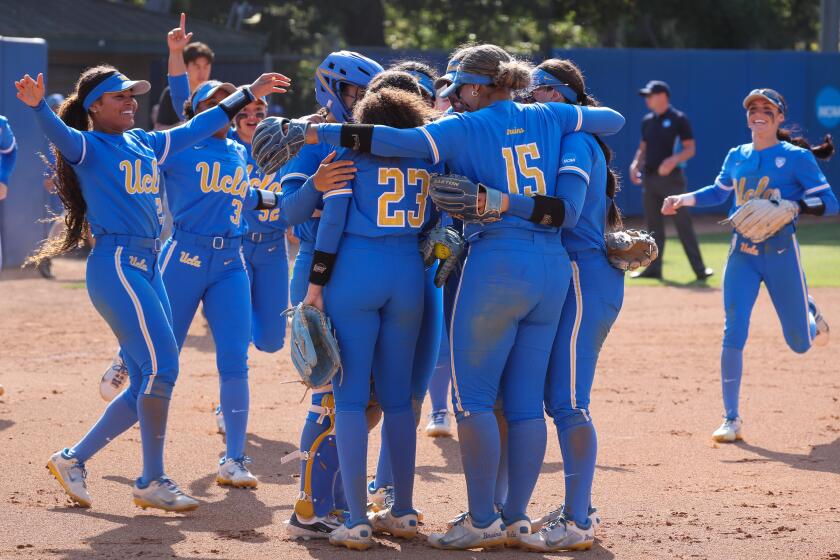Red, White & Whew!
It was a typical practice for the San Antonio Spurs right after the merger.
That is, it wasn’t much of a practice.
Most of the players were shooting around at one end of the court while some kids mopped up a little gift the coach’s dog had left at the other.
The Spurs, a “new” team from the American Basketball Assn., were renowned for not playing defense and, moreover, not having plays. Now word was getting out that they were barely having practices.
How could the NBA take these guys seriously when they didn’t seem to take themselves seriously?
But what the Spurs, and their ABA brethren, brought to the NBA was almost undefinable.
They brought serious fun.
On Wednesday, the serious fun begins as the Spurs become the first of the four ABA merger teams to play in the NBA finals. And you can bet the New York Knicks are taking them seriously.
It was 23 years ago that the NBA accepted four teams--the Spurs, Denver Nuggets, Indiana Pacers and New York Nets--from the ABA, a league formed by Dennis Murphy in 1967 with the hope of forcing a merger with the NBA. In the first season there were 11 teams spanning from the Anaheim Amigos to New Jersey Americans. The ABA had 10 teams at the start of its last season, 1975-76, but three teams folded before the All-Star break. By the end of the season, Denver and New York were trying to make deals to get into the NBA, which led to the negotiations for the merger.
For the privilege of playing in the NBA, the Spurs, Nuggets, Pacers and Nets--chosen for their financial viability--paid $3.2 million, a hefty price in those days. The teams were allowed to keep their players; players from the other ABA teams were available in a dispersal draft.
The Spurs and Nuggets had immediate success--both made the playoffs in 1977, with the Nuggets reaching the conference semifinals before losing to eventual champion Portland--and it seemed possible that one of the teams would show the old league that the free-wheeling players of the ABA were just as good.
They did, though after the initial success, the ABA teams have had far less impact than ABA players.
“When 10 of 24 players at the [1976-77] All-Star game were from the ABA and when half of the starters in the [1977] NBA finals [were from the ABA], that made us enormously proud,” said Bob Costas, who has become one of the ABA’s most visible graduates because of his success with NBC. Costas got his start in broadcasting as the play-by-play man for the Spirits of St. Louis, which did not survive the merger. “After the merger, I rooted for anything that showed the ABA as being just as good if not better than the NBA.”
While ABA star Julius Erving energized NBA television ratings by taking his new team, the Philadelphia 76ers, to the finals in 1977, it was 22 years before an ABA team reached the finals.
San Antonio fans will point out that the Spurs are a team with tradition and impact. The Spurs are the only ABA team to reach the conference finals in the 1970s, ‘80s and ‘90s, they won five division titles in the six seasons after the merger and the Alamodome has proven a difficult place for visiting teams, as was the HemisFair Arena.
And San Antonio players such as George “the Iceman” Gervin, Olympian Alvin Robertson and, more recently, David Robinson and Tim Duncan--have captured the imagination of fans. And, of course, they had Dennis Rodman before the Bulls or the Lakers.
*
When people refer to the ABA, it starts with the red, white and blue ball.
Minneapolis Laker legend George Mikan was the first ABA commissioner and he insisted on the ball to give the league an instant identity. Although the ABA never escaped the derision of being the “Beach Ball League,” the ball became an enduring icon. Players were initially reluctant to use the ball, but by the time of the merger they swore allegiance to it because it was easy to see the rotation.
There were other enduring images of the ABA: big hair, big collars, big bell bottoms, tall socks and short-shorts. And, oh yes, there is the image of Dr. J winning the dunk contest at the 1976 All-Star game. Erving launched from the free-throw line--that was a big deal then--to beat Denver’s David Thompson. The move was emulated by Michael Jordan to win an NBA slam dunk contest and become the icon for his line of shoes.
But the ABA’s legacy is more than beach ball, quirky ‘70s stuff and promotions.
Nearly everything the ABA did, from promotions to rule changes, was adopted by the NBA. The ABA introduced the three-point line to the professional game, considered nearly blasphemous at the time. Now it’s an industry standard.
Dan Cook of the San Antonio Express News related former Spur president Angelo Drossos role in bringing the arc to the NBA. Drossos reportedly enraged Boston Celtic general manager Red Auerbach by continuing to pitch the idea at owners meetings. When the league adopted the three-point line in 1979 Auerbach is said to have growled at Drossos, “I guess next you’ll want to sell those silly red, white and blue basketballs.”
Said Drossos: “I was going to get to that next, Red, because I’ve got about four dozen I’ll sell real cheap.”
Now it’s part of the All-Star weekend competition.
Similarly, the dunk was once an outlawed form of scoring. There was a no-dunk rule in college basketball and it was considered almost a vulgar display of selfishness by NBA elitists, but it was a selling point for the ABA, which put together a dunk contest to help promote the 1976 All-Star game.
“What the ABA did in terms of style of play is bring the notion that you can be flamboyant and still be a team player,” Costas said.
Thus the Laker “Showtime” offense and the so-called “small” lineups can be traced to the ABA. The style of play affected the NBA so much that teams became much more creative about disguising their zone defenses to clog up the middle when slashers like Erving and Gervin would go into the lane.
Today’s stand-around offenses are based on breaking down those zone defenses and forcing a team technical foul if the defense does not break out of it.
The Spurs were one of the first to advance the small lineup and unselfish style of play. In Coach Doug Moe’s motion offense, the point was to keep moving and passing until someone got open.
OK, so there weren’t many set plays, but Gervin won the 1978 scoring title playing that systemand the Spurs took a 3-1 advantage in the 1979 Eastern Conference finals before losing to the Washington Bullets (now Wizards).
Players from that Spur team, such as guards Gervin and James Silas, still live in the San Antonio area and are visible in the community.
“The teams and their communities still have strong ties with the ABA. The ABA banners are up in the arenas and they remember,” Costas said. “There is a tremendous camaraderie in the league among those who were in the ABA. When I see Jess Kersey, or anyone who was in the league, they all immediately make an ABA reference.
“I didn’t root for the Pacers so that there would be an all-ABA final. Broadcasters don’t root for teams, at least I know I don’t--it just gets in the way. But it would have been a good story line to have two ABA teams. As a broadcaster you try to be aware of all of them.
“But I probably would have appreciated the story in a different way than others who weren’t so close to the league.”
NBA FINALS
NEW YORK vs. SAN ANTONIO
Game 1: Wednesday at San Antonio 6 p.m., Channel 4
More to Read
Get our high school sports newsletter
Prep Rally is devoted to the SoCal high school sports experience, bringing you scores, stories and a behind-the-scenes look at what makes prep sports so popular.
You may occasionally receive promotional content from the Los Angeles Times.






